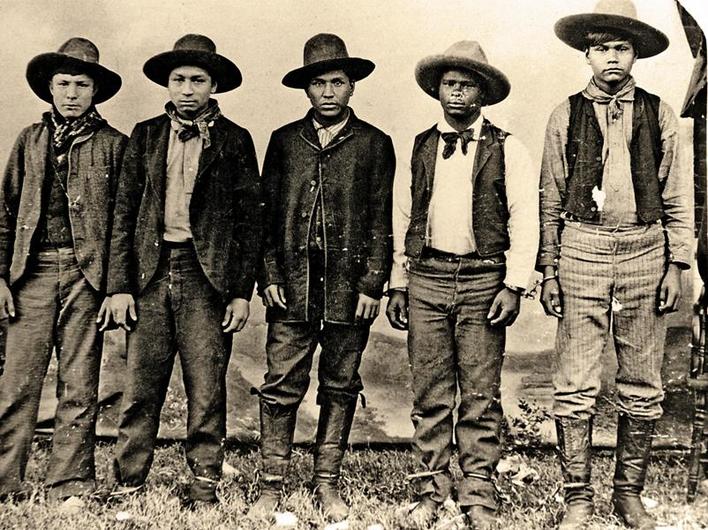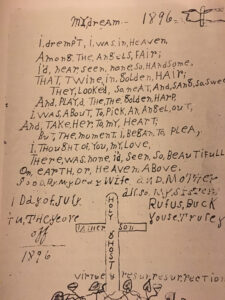The Ruthless Reign of the Rufus Buck Gang: Terrorizing the Midwest in the Late 1800s
June 3, 2023
The only known photograph of the Rufus Buck gang, taken in the summer of 1895
in Indian Territory. Buck is in the middle. Photograph courtesy of Leonce Gaiter
The Rufus Buck Gang was an outlaw Native American gang whose members were Creek Indian and African American. Their crime spree took place in the Indian Territory of the Arkansas-Oklahoma area from July 30, 1895, through August 4 of 1896.
The Rufus Buck gang’s exploits were relatively short-lived, but they were certainly brutal enough to go down in the most heinous tales of Western outlaw history.
In the annals of American history, the Rufus Buck Gang stands as a symbol of lawlessness and terror during the late 1800s. Comprising five members led by Rufus Buck himself, this notorious group of outlaws left a trail of bloodshed and fear across the Midwest.
THEIR CRIME SPREE LASTED TWO WEEKS!
The Rufus Buck Gang was an infamous criminal outfit that operated primarily in the Indian Territory, which is present-day Oklahoma, during the late 19th century. The gang consisted of Rufus Buck, a Creek-Seminole Indian, and four other young men—Maoma July, Lewis Davis, Lucky Davis, and Sam Sampson. This diverse group united in their shared grievances against the injustices inflicted upon Native American tribes by the American government.
The True Story of The Harder They Fall’s Villain Is Even Weirder Than in the Movie … Rufus Buck was much younger, and angrier, in real life.
Freedom. Freedom to right wrongs. Freedom to strike back. Freedom to revel in revenge. These are freedoms denied Black people throughout American history. We’re not even allowed to openly contemplate revenge for the centuries of enslavement, brutality, rape and other forms of violence heaped on us. Denying ourselves thoughts of retaliation that would plague any human treated as we have been is just another form of denying our full humanity.
After the death of Rufus Buck as a historical fact, a photo of his mother was found in his jail cell along with this poem written on the back. Click for full size.
The Netflix film The Harder They Fall, as with other recent movies like Django Unchained and The Birth of a Nation, tries to right this wrong and mythologize Black historical figures as independent rebels who take no shit, and will kill you for saying a word that even starts with “N.” The film, directed by Jeymes Samuel, employs historical characters, but makes up entirely new stories about their lives. These characters include Cherokee Bill (Lakeith Stanfield), a half-Cherokee, half-black outlaw raised by his black grandmother; Bill Pickett (Edi Gathegi), a cowboy and Wild West show performer; and Bass Reeves (Delroy Lindo), a U.S. Deputy Marshal who worked in what was then “Indian Territory”—today’s Oklahoma.
Then there is Rufus Buck—a historical figure who was fascinatingly, enigmatically unique. In the film, Buck is played by Idris Elba, who is 49. However, the real-life Buck was at most 21 years old when he was executed by order of “Hanging Judge” Isaac Parker in 1895. That’s the first, but not the last, liberty the film takes in adapting his story. Buck’s actual life, or what we can glean of it, deserves its own stage.
Some accurate information about Buck is available, but there is nothing close to a detailed life story. There are records of his arrests, and press accounts, but the latter cannot be fully trusted, since the advocacy journalism of the time portrayed Black and Native offenders as particularly evil and threatening. Buck went from being a very young man, arrested and jailed for selling illicit liquor, to the most wanted man in the Indian Territory. By all accounts, his gang threatened, maimed, killed, terrorized and raped, putting him right in the league of a Jesse James.
The Dawes Act of 1887 played a significant role in the emergence of the Rufus Buck Gang. The act aimed to assimilate Native Americans by dividing communal tribal lands into individual allotments, thus undermining the traditional communal lifestyle. This legislation disrupted Native American communities, destroyed their self-sufficiency, and led to increased poverty and displacement.
Driven by the profound anger and resentment resulting from the Dawes Act, Rufus Buck and his gang sought to challenge the oppressive system and fight back against the injustices they witnessed within their communities. Their crimes were fueled by a sense of desperation, as they sought to strike fear into the hearts of those they perceived as oppressors.

Photo of Isaac Parker taken between 1860 and 1865
The Rufus Buck Gang carried out a series of brazen crimes that shook the Midwest during their brief reign of terror. Their modus operandi included robbery, assault, and murder. Notably, they targeted prominent white individuals and members of law enforcement, symbolically striking back against the perceived oppressors of Native American tribes.
In one of their most heinous acts, the gang attacked the home of Judge Isaac Parker, a federal judge known as the “Hanging Judge” due to his strict approach to law enforcement in the Indian Territory. The gang killed Judge Parker’s son and escaped with firearms, ammunition, and other valuables.
The ruthless exploits of the Rufus Buck Gang eventually caught up with them. After a series of intense manhunts, the gang members were captured in July 1895. They were swiftly put on trial for their crimes. Rufus Buck, Maoma July, Lewis Davis, and Lucky Davis were found guilty of murder and sentenced to death by hanging.
From “Old West Newsletter:”
The guilty verdicts for the men came quickly — their juries deliberated for just minutes — but the cases were appealed and sent to the Supreme Court, a de facto legal move many outlaws in Indian Territory took up as a way to fight back against Parker’s heavy-handed judicial reign.
But the Supreme Court refused to overturn Parker’s results, and in the spring of 1896, the five men were once again sentenced to hang. On the last night in June, the outlaws prayed, sung hymns and spent time with Father Pius, who had also baptized the group.
It was a strange turnabout for the five men who spent two weeks in the summer of 1895 terrorizing citizens of the Creek Nation. They had killed a deputy marshal, assaulted individuals and families, raped women, robbed stores and in general caused the type of mayhem that put an entire region on high alert.
“It is not considered safe for women to go about, and many of the homes are under partial guard of the men folks on the places, in fear that the gang may visit them to do violence,” reported the Cherokee Advocate.
Now, there was no more evading the inevitable, and the outlaws made their way calmly to the infamous trap door at Fort Smith’s gallows, nicknamed the “Gates of Hell” for all the convicts it had put to death.
There wasn’t much of a crowd: Buck’s father was present, drunk, and sisters of Sam Sampson and Lucky Davis were also in attendance. The days of large public gatherings for hangings at Fort Smith were over, and on this day, few onlookers witnessed the final minutes of Rufus Buck and his peers.
It was the last group hanging at Fort Smith under the watch of Judge Parker — the court’s jurisdiction over Indian Territory would end two months later — and one of the final chapters of that gallows’ storied history.
However, the case of Sam Sampson, a minor who was also a member of the gang, received significant attention. Activists argued that his youth and the influence of the older gang members should be considered as mitigating factors. Ultimately, Sampson’s sentence was commuted to life imprisonment.
The Rufus Buck Gang remains etched in history as one of the most notorious criminal groups to have terrorized the Midwest during the late 1800s. Their violent campaign, fueled by the injustices imposed on Native American tribes through the Dawes Act, represented a desperate outcry against an oppressive system. While their actions were reprehensible, the legacy of the Rufus Buck Gang serves as a stark reminder of the consequences that can arise from systemic injustices and the importance of addressing grievances to prevent further violence and lawlessness.
